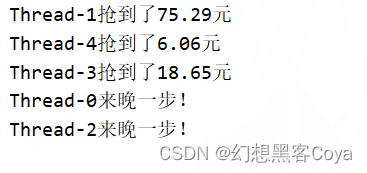目录
一.案例:五个人抢红包
二.案例:两个抽奖池抽奖
三.案例:两个抽奖池抽奖:获取线程运行的结果
四.线程池:用来存放线程,避免多次重复创建线程
五.自定义线程池
六.最大并行数与线程池大小
一.案例:五个人抢红包
1.如何保证只留下两位小数,并且计算精确呢? 使用大浮点数类,使用setScale方法保留小数 2.如何保证随机的数字最小是一分钱呢? 设置最小中奖金额,如果随机到的数字小于这个数的话,就让这个数变成这个最小金额 同时也需要保证最大的金额不会大到把剩下人的一分钱(最小金额)也给吞掉了 3.如果说是最后一个抽到红包的,还应该去随机数字吗 直接把剩余的钱款给最后一个即可在这里的随机金额中先抢的概率更大-这或许也是不合理的地方
public class Demo321 {public static void main(String[] args) {MyThread t1 = new MyThread();MyThread t2 = new MyThread();MyThread t3 = new MyThread();MyThread t4 = new MyThread();MyThread t0 = new MyThread();t1.start();t2.start();t3.start();t4.start();t0.start();}
}public class MyThread extends Thread {static BigDecimal money = BigDecimal.valueOf(100);static int count = 3;static final BigDecimal MIN = BigDecimal.valueOf(0.01);@Overridepublic void run() {synchronized (MyThread.class) {if (count == 0) {System.out.println(Thread.currentThread().getName() + "来晚一步!");return;}BigDecimal price;if (count == 1) price = money;elseprice = BigDecimal.valueOf(new Random().nextDouble(MIN.doubleValue(),money.subtract(BigDecimal.valueOf(count-1).multiply(MIN)).doubleValue()));count--;price = price.setScale(2, RoundingMode.HALF_UP);money = money.subtract(price);System.out.println(Thread.currentThread().getName() + "抢到了" + price + "元");}}
}

二.案例:两个抽奖池抽奖
public class Demo322 {public static void main(String[] args) {MyThread t1 = new MyThread();MyThread t0 = new MyThread();t1.start();t0.start();System.out.println("到这一行就开启了三条线程");System.out.println("main方法是运行在main线程中的栈,线程12开启的时候在内存中会多出两个栈:线程一的方法栈和线程2的方法栈");}
}
public class MyThread extends Thread {static ArrayList<Integer> arrayList;static {arrayList = new ArrayList<>();Collections.addAll(arrayList, 10, 5, 20, 50, 100, 200, 500, 800, 2, 80, 300, 700);}@Overridepublic void run() {ArrayList<Integer> myArraylist = new ArrayList<>();while (true) {synchronized (MyThread.class) {if (arrayList.size() == 0) break;int index = new Random().nextInt(arrayList.size());Integer i = arrayList.get(index);arrayList.remove(index);myArraylist.add(i);}}synchronized (Thread.class) {if (myArraylist.size() == 0) {System.out.println("在此抽奖过程中,"+getName() + "没有产生任何奖项");return;}System.out.println("在此抽奖过程中," + getName() + "共产生了" + myArraylist.size() + "个奖项" + "分别为");StringJoiner sj = new StringJoiner(",");Integer count = 0;Integer max = myArraylist.get(0);for (Integer integer : myArraylist) {sj.add(integer + "");count += integer;if (integer > max) max = integer;}System.out.println(sj + "," + "最高奖项为" + max + "元," + "总计额为" + count + "元");}}
}

三.案例:两个抽奖池抽奖:获取线程运行的结果
public class Demo323 {public static void main(String[] args) throws ExecutionException, InterruptedException {MyCallable myCallable = new MyCallable();System.out.println("需要注意的点:这里要创建两个多线程运行结果的管理对象");FutureTask<Integer> futureTask0 = new FutureTask<>(myCallable);FutureTask<Integer> futureTask1= new FutureTask<>(myCallable);Thread t0 = new Thread(futureTask0);Thread t1 = new Thread(futureTask1);t0.start();t1.start();Integer i0 = futureTask0.get();Integer i1 = futureTask1.get();System.out.println("在这个抽奖过程中");if (i1==null||i0>i1){System.out.print(t0.getName()+"抽到了最大奖项,该奖金金额为:"+i0+"元");}else {System.out.print(t1.getName()+"抽到了最大奖项,该奖金金额为:"+i1+"元");}}
}
class MyCallable implements Callable<Integer> {static ArrayList<Integer> arrayList;static {arrayList = new ArrayList<>();Collections.addAll(arrayList, 10, 5, 20, 50, 100, 200, 500, 800, 2, 80, 300, 700);}@Overridepublic Integer call(){ArrayList<Integer> myArraylist = new ArrayList<>();while (true) {synchronized (MyThread.class) {if (arrayList.size() == 0) break;int index = new Random().nextInt(arrayList.size());Integer i = arrayList.get(index);arrayList.remove(index);myArraylist.add(i);}}synchronized (Thread.class) {if (myArraylist.size() == 0) {System.out.println("在此抽奖过程中,"+Thread.currentThread().getName() + "没有产生任何奖项");return null;}System.out.println("在此抽奖过程中," + Thread.currentThread().getName() + "共产生了" + myArraylist.size() + "个奖项" + "分别为");StringJoiner sj = new StringJoiner(",");Integer count = 0;Integer max = myArraylist.get(0);for (Integer integer : myArraylist) {sj.add(integer + "");count += integer;if (integer > max) max = integer;}System.out.println(sj + "," + "最高奖项为" + max + "元," + "总计额为" + count + "元");return max;}}
}

四.线程池:用来存放线程,避免多次重复创建线程
提交任务时,线程池会创建新的线程对象,任务执行完毕之后,线程归还给池子 1.下次再创建任务的时候还需要创建新的线程吗? 不需要再创建新的线程,复用已经有的线程即可 2.如果提交任务的时候池子里面没有空闲线程,就无法创建新的线程,任务会如何进行? 任务就会排队等待3.线程池创建过程? 1.创建线程池 2.提交任务 3.所有任务执行完毕时,关闭线程池(实际开发中线程池一般不会关闭)4.创建线程池的快速方法? 使用Executors(执行人)的静态方法创建线程池5.如何创建无上限的线程池? 6.如何提交任务? 7.如何停止线程? 8.如何创建有上限的线程池?
public class Demo324 {public static void main(String[] args) throws InterruptedException {System.out.println("5.使用Executors的newCachedThread方法获取线程池对象(cached-缓存),无上限");ExecutorService pool = Executors.newCachedThreadPool();System.out.println("6.使用线程池的submit方法提交任务,这里的输出的线程池名字与线程名字编号都是从1开始的");pool.submit(new MyRunnable());pool.submit(new MyRunnable());Thread.sleep(1000);//在这里睡了一小会之后使用的还是原来的线程:不会创建新的线程(用线程一还是线程二是随机的)pool.submit(new MyRunnable());Thread.sleep(1000);System.out.println("7.使用线程池的shutdown方法停止线程");pool.shutdown();Thread.sleep(1000);System.out.println("8.使用Executors的newFixedThreadPool方法创建有上限的线程池");pool = Executors.newFixedThreadPool(1);pool.submit(new MyRunnable());pool.submit(new MyRunnable());pool.shutdown();}
}
public class MyRunnable implements Runnable{@Overridepublic void run() {for (int i = 0; i < 10; i++) {System.out.println(Thread.currentThread().getName()+":"+i);}}
}


五.自定义线程池
自定义线程池 参数如下: 1.核心线程数量(核心员工) 2.线程中最大线程数量(包括临时员工) 3.4.临时线程空闲时间与单位(临时员工存活时间) 5.阻塞队列 6.创建线程的方式 7.要执行任务过多的解决方案创建临时线程的时机是在什么时候? 阻塞队列满了之后才能创建,不是核心线程被占满了才创建,创建临时线程处理队伍之外的任务!
public class Demo325 {public static void main(String[] args) {ThreadPoolExecutor tpe = new ThreadPoolExecutor(3,6,60,TimeUnit.SECONDS,//时间单位new ArrayBlockingQueue<>(3),//不想指定长度就写LinkedArrayBlockingQueueExecutors.defaultThreadFactory(),//创建线程工厂,底层是创建Thread线程new ThreadPoolExecutor.AbortPolicy()//静态内部类(依赖于线程池,单独存在无意义),任务的默认拒绝策略:抛错);tpe.submit(new MyRunnable());tpe.submit(new MyRunnable());tpe.submit(new MyRunnable());tpe.submit(new MyRunnable());tpe.submit(new MyRunnable());tpe.submit(new MyRunnable());tpe.submit(new MyRunnable());tpe.submit(new MyRunnable());tpe.submit(new MyRunnable());tpe.shutdown();}
}
在上面代码基础上再加一个线程会报错:

六.最大并行数与线程池大小
最大并行数:和CPU有关 Intel利用-超线程技术-使得每个核有两个线程 在设备管理器可以查看 1.如何获取最大能够使用的线程?2.线程池开多大合适呢? 项目一般分为:CPU密集型(计算比较多)和IO密集型(读写文件多) CPU密集型: PU运算比较多,最大并行数+1(1是备用池)即可 IO密集型(大多数项目): 最大并行数(8)*期望CPU利用率(占满100%)*[(计算时间+等待时间(等待IO流))/计算时间]这个需要用工具(thread dump)计算
public class Demo326 {public static void main(String[] args) {System.out.println("2.使用Runtime.getRuntime().availableProcessors()获取当前最多能够使用的线程");System.out.println(Runtime.getRuntime().availableProcessors());}
}




———React如何像Vue一样将css和js写在同一文件)
)

)



![C++初阶 | [七] string类(上)](http://pic.xiahunao.cn/C++初阶 | [七] string类(上))



《Linux操作系统原理分析之linux存储管理(5)》(21))


》第2章-计算机系统基础知识-03-嵌入式)
